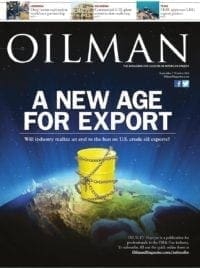North America’s oilfields are running at full speed, evidenced by the boom in the Bakken, the consistent growth in the Eagle Ford Formation and Permian basin, the gas fields of the Utica and Marcellus shale areas, and the talk of fresh shale plays in Louisiana, Mississippi and several other parts of the United States. From the larger oil companies in transportation, drilling, fracking, welding, pipe, valves and supply to the smaller support services, it seems that every type of company is trying to get their share of this black gold rush and the resulting fortune.
Years ago, I worked selling pipe to mining operators in Nevada. During my time there, I made a lot of cold calls trying to build relationships and compete with other professionals that had more experience and time in the area. Eventually I began taking road trips from San Francisco to Salt Lake, visiting every mine and distributing company I could find in between. Today, I’m faced with a similar challenge as I hit the road again in October and make the transition from Marketing Director of a factoring company to Business Development Officer in the Texas oilfields. In light of my sales and marketing experience and a few mistakes I made, there are few things I feel I can share that improved the return on my efforts. I’ve listed some tips here that might help you successfully market in the oilfields.
When it comes to marketing in the oilfield arena, consider these key things before throwing money into a campaign and expecting to see a return.
The “Good Ol’ Boys’ Club”
My recent visit to the Oilman Fishing Charity Tournament in Matagorda Bay allowed me to meet professionals in the industry and get a better understanding of the culture. After a few days, people noticed that I was consistently there, that I was invested, and that I was part of what was going on. That familiarity made it easier to introduce myself. By day six, I had made several new connections. It’s not too different than the mining industry where everyone knows everyone. Though the oilfield industry is enormous, it is culturally a small community. To survive in the “Good Ol’ Boys’ Club,” you have to show consistency and create visible ties to the industry. Don’t expect results if you just show up once, make a pitch and bail. You’re either committed or you’re not, and for better or for worse, your commitment is transparent.
When in Rome
If I were to show up to an oilfield service company driving a BMW and sporting a button-down shirt, checking the time on my Rolex, the first impression would be that I don’t belong, that I can’t relate. Fortunately for me, the culture blending is natural: I drive a pickup truck and grew up working several jobs getting my hands dirty. It shows that I have no problems doing it again and creates a connection. Make sure you fit the profile. You must communicate verbally and non-verbally with people on a level they relate to make them feel comfortable dealing with you.
Sell without selling
I have watched young sales reps try pitch after pitch, gimmick after gimmick to get a product sold. My advice is to stop selling your product, and start self-selling; build a relationship. The product or the company you represent won’t be noticed until you are, and won’t be taken seriously until you’ve formed a trust-based relationship with your client.
Referrals
When the oil industry has an upswing, there are always new players coming into the game. Remember to put yourself out there as eyes and ears for their business, and they might do the same for you. Let them know if you see opportunities in their market, and that you’ll be happy to refer them and refer others to them. Be altruistic– it will only benefit you down the road as you help them become successful.
Experience
Below, I have listed a few thoughts on marketing to oilfield businesses from a corporate marketing perspective. Some of these may be effective in certain industries, but if you are a small company with a limited budget, consider what I learned and came to understand about the necessity of physically going into the fields to sell and market.
“Location, location, location” is what they say in real estate. The same mantra applies when marketing to the oilfields. Companies chasing oil are setting up in the sticks, way out in no-man’s land, with virtually no contact to the outside world. Most of time the whole operation consists of the men running the rigs, some essential management, a company man and a few people from support companies on daily runs. Purchasing agents and higher executives most likely office far away in another city and marketing to them necessitates a different approach.
Billboards are the most commonly used form of advertisements in these areas and, not coincidentally, will be some of the most expensive pieces of marketing real estate you will find. Ask yourself if your target customer will pay attention to your billboard at 70mph. Can they absorb the information at that speed? Probably not. If you find a site in a nearby town where the traffic slows down, you might have a better chance. Choose your site carefully and make your ad as simple and to the point as possible. Focus less on the design and more on the message; it will be pointless in the end if the information doesn’t sink in. Make sure you choose a standalone billboard. Advertising for a few seconds on a rotating electric sign means your ad won’t be in front of all the time. Remember that the companies that run them will squeeze as many ads in as possible. Without monitoring, your exposure can become fatally limited.
Radio ads are another common avenue for advertisement in the oilfields, but can be prohibitively expensive. I wanted to run an ad in the environs of Corpus Christi with a large, very popular local radio station. They happily responded to me with a minimum ad requirement and a bid at $40k, way out of my budget. I opted instead to run the ad with a smaller local station in the area at $1-2k per campaign, but soon realized that the ROI was not really there. If you want a cost-effective campaign, remember that with a smaller radio station, they won’t have the signal, and therefore the reach, and eventually they lose listeners because of this issue and your exposure decreases. If you choose a large radio station, carefully monitor your ROI. The ad may reach your target demographic, but remember that these stations have contracts with 3rd party advertisement agencies and are extremely expensive.
Bus advertisement sounded like a great idea. I notice bus ads all the time around town. They are big, have great visual impact and are less expensive than most other advertisements (around $300 per month with a $250 set fee). Evaluate your impact carefully. Ask, when is someone going to write that number down, or read it all in traffic? Bus ads are great for brand recognition and exposure, but in my experience, they didn’t make the phone ring, and ended up not having the ROI I hoped for.
Movie advertisement felt like a hidden gem. I placed an advertisement in Minot, ND that showed before every movie. It showed 14,800 impressions during the life of the contract—great exposure for the price. The campaign didn’t bring in one client. It was worth trying, but I can’t recommend it.
I hope sharing my experiences will help you make better marketing and sales decisions for your company in the future. If you are in Texas or the oilfields, I welcome your call or LinkedIn invitation. I’m always excited to help growing businesses and I’m happy to offer any marketing advice you might need.










